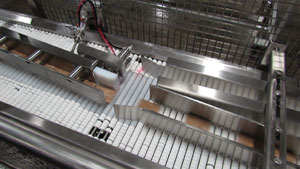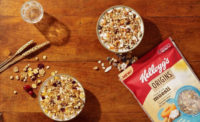Datrex is one of the world’s leading manufacturers and distributors of safety and survival equipment and supplies used in the commercial marine industry. Critical among these survival necessities are food bars which, over the past 20 years, has become a continually expanding product line for Datrex in emergency preparedness kits used during earthquakes, flooding and hurricanes.
In mid-2011, Datrex opted to expand and upgrade the line to increase its throughput volume. “We got to a point where we had so many orders coming in that the line just could not handle the production requirements anymore,” says Scott Mills, executive vice president, operations at Datrex. The line manufactures and packages two sizes of survival food bars: 2,400 calorie and 3,600 calorie bars, both made with all-natural ingredients, and supporting a five-year shelf life.
From the early 1990s, the Datrex food bar line was primarily a manual process. The production process used a tablet depress to compact the product to approximately 3- x 4- x 3-in. cubes. In 2008, Datrex upgraded the speed and performance of its tableting machine to a multi-station rotary press to improve throughput.

|
| An automated diverter feeds bars to each of the line’s shrink wrappers on conveyors with Slip-Torque technology, which minimizes product damage. Source: Shuttleworth Inc. |
Once manufactured, the bars were conveyed to a shrink wrapper, individually wrapped, run through a heat tunnel and sealed, then manually placed into pouches that were vacuumed sealed, boxed, palletized and put into storage or sent straight to shipping.
Throughput on this line was governed by the speed of the existing wrapper. But escalating sales volumes demanded higher throughput. To handle these production levels, the company needed to expand the throughput capability of the downstream packaging line. To engineer a solution, Datrex reviewed design proposals from a number of packaging manufacturers. It selected Conflex to design a shrink wrap solution and Shuttleworth to engineer an automated conveyor and wrapper infeed solution.
A unique aspect of the new packaging line is its split-wrapping functionality. Instead of designing a line where one wrapper runs at exceptionally high speeds, opening the door for jam-ups, miswraps and accelerated equipment wear, the Conflex/Shuttleworth design team maintained the existing wrapper and added a second, higher-throughput capability wrapper, integrating the two wrappers into two separate-but-integrated shrink lines.
After the food bars exit the tableting stations, they are conveyed in single file through a section of specialized accumulation conveyors with low back pressure, called Slip-Torque, before being diverted into one of two separate lanes destined for the different wrappers. Conveyors with Slip-Torque have the ability to modulate the speed of different sections of the conveyor via a central control PLC and HMI. Then, an automated diverter feeds a preset number of bars into the slower, original wrapper lane and feeds a larger quantity of bars into the lane with the faster wrapper. Each wrapper is fed the proper proportion of food bars relative to its speed capability.
Completed in March 2012, the new packaging line is a model of throughput efficiency, with the capability of processing a high volume of ration bars through the line with a minimal defect rate. “With the installation of the new packaging system, we have increased our production capacity by more than 125 percent compared to what we were previously running,” explains Mills.
For more information: Shuttleworth, 260-359-7850, t.eckert@shuttleworth.com





